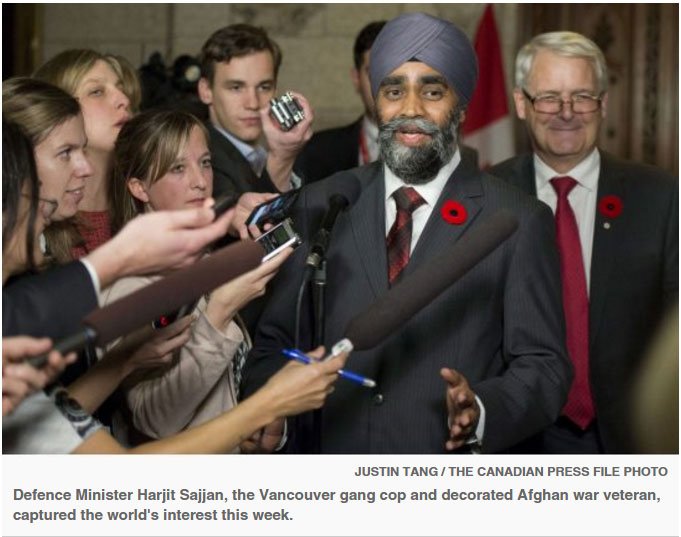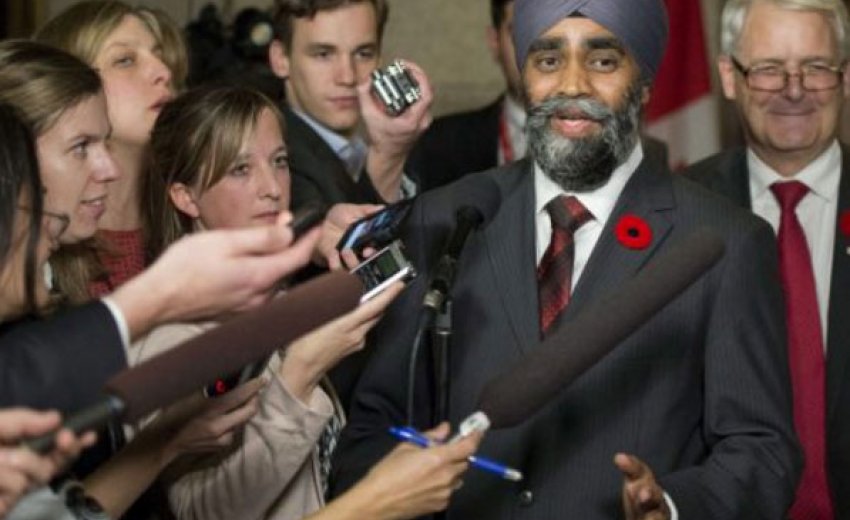
Not many federal cabinets have attracted global attention like the diverse one named by Liberal Prime Minister Justin Trudeau this week.
The decision to name four Sikhs won the new government praise from Burma to Australia to Trinidad and Tobago and many spots in between.
But apart from Vancouver, Mississauga, Waterloo and Edmonton — the respective hometowns of Defence Minister Harjit Sajjan, Industry Minister Navdeep Bains, Tourism Minister Bardish Chagger and Infrastructure Minister Amarjeet Sohi — pride is probably felt deepest in the Indian state of Punjab, the spiritual home of Sikhs around the world.
“This is everywhere,” said Ek Ong Kaur Khalsa, program director of Sikhnet, an Espanola, New Mexico-based website that publishes Sikh-focused news. “This is just going viral.”
The obvious object of the world's interest and envy is Sajjan, the Vancouver gang cop and decorated Afghan war veteran who is currently fending off a bombardment of interview requests as he prepares for his new responsibilities. But the other is that Trudeau's cabinet now contains more Sikh cabinet ministers than that of India.
For longtime political organizers like Brampton Liberal Inderjit Singh Bal, who was hidden away when he first volunteered during the 1979 federal election campaign, the tint of the government's new executive branch is a sign of how far the country has come.
Of that first campaign, in which Liberal prime minister Pierre Trudeau would lose to Progressive Conservative leader Joe Clark, Bal recalled: “(Campaign workers) looked at me and they asked, 'Can you speak English?' They didn't want to send me to the people's doorsteps to show my face.”
A decade later, Bal helped organize an influential delegation of about 285 Sikhs at the Liberal leadership convention that elected future prime minister Jean Chrétien, which paved the way for a historic cabinet appointment when Sikh MP Herb Dhaliwal was elected in 1993.
The collective surprise this week that four Sikhs were appointed to cabinet — and the fact that we are still talking about it days later — also shows, however, how far we still have to go, said former Liberal cabinet minister Ujjal Dosanjh, who is himself Sikh.
“I'd rather go back to Mr. Trudeau's comment: 'It's 2015. Get with it,' It's something that you should expect. If it didn't happen then you should ask questions,” he said.
For Dosanjh, who is retired from politics and writing his autobiography, the absence of any Chinese-Canadians from the cabinet, despite three Liberal GTA MPs, is a more glaring oversight.
None of this debate, though, is enough to wipe the grin off the face of Satwinder Kaur Bains, director of the Centre for Indo-Canadian Studies at the University of the Fraser Valley in Abbotsford. B.C.
“It's a very uplifting time. I feel like we've finally arrived and said, 'Look, we are Canadians. (Sajjan is) defending our country — that says a lot,” she said.
But she is also aware that with the Sikh community's achievement comes great responsibilities — for the four newly minted ministers as well as the million-or-so Sikhs who live in this country.
“One is an internal hope because we are so proud and we have this amazing opportunity so let's make the most of it and let's make sure the light shines on us and we don't shy away from the responsibility,” Bains said.
“But I think there is a second piece which is really about . . . letting Canada know that this is something we are going to take on with confidence and not be second guessed as Canadians because I think the hyphenation of Canadians continues to haunt us and dog us.”
The evolution of Canada's political landscape to match that of its demography has always lagged a little bit. As Dosanjh noted, the story of inclusive cabinet-making starts in the 1970s with status Indian Leonard Marchand's term as environment minister under Pierre Trudeau. It passes through Lincoln Alexander, the first black cabinet minister under Brian Mulroney, and continues with Chrétien, who appointed Dhaliwal, as well as the first Chinese minister, Hong Kong-born Raymond Chan, to his cabinets.
But this week is a definite turning point in the evolving identity of Canada's Sikh community, said Bains.
The new federal ministers, and other Sikh politicians like Bramalea-Gore-Malton MPP Jagmeet Singh, the deputy leader of Ontario's NDP, are the children of the first wave of Sikh immigrants who left India in the 1970s and 1980s either to get away from political persecution and unrest or to seize the economic promise in a far away land.
In the country's legislatures they have championed the recognition of a Sikh genocide in the deadly riots that occurred following the assassination of Indian prime minister Indira Gandhi by her Sikh bodyguards, a killing prompted by the Oct. 31, 1984 attack by Indian troops on the Golden Temple in 1984, Sikhism's holiest site.
This new generation of Sikh-Canadian politicians is just as likely to campaign with all their energy for Canadian national unity should the future need arise. For most, this country is the only real home they have ever known, said Bains.
“This group is really taking the world by storm in a sense and if you really talk to them deeply about identity politics, they see themselves as very much Canadians. They have their Indian identity as well, but their affiliation to Canada is very, very strong.”
The exploits of Harjit Sajjan
He was a Vancouver Police officer for 11 years, ending up as a detective investigating gangs, drugs and organized crime.
Sajjan served as a Canadian Forces reservist, deploying to Bosnia in the 1990s and doing three tours as an intelligence officer in Kandahar, Afghanistan.
In a 2006 Afghanistan tour, Brig. Gen. David Fraser wrote in a letter obtained by the National Observer that Sajjan was selected for a military intelligence job because of his experience as an undercover narcotics officer.
Fraser's letter, to Vancouver's police chief, said: “He was the best single Canadian intelligence asset in theatre, and his hard work, personal bravery and dogged determination undoubtedly saved a multitude of Coalition lives.”
Sajjan created and patented his own version of the gas mask that would fit over his beard, according to Foreign Policy.
He has received numerous recognitions for his military service, including the Meritorious Service Medal, the Order of Military Merit and a Mention in Dispatches.
